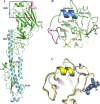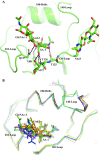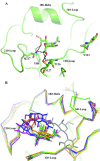Structure and receptor complexes of the hemagglutinin from a highly pathogenic H7N7 influenza virus
- PMID: 22674977
- PMCID: PMC3421765
- DOI: 10.1128/JVI.00281-12
Structure and receptor complexes of the hemagglutinin from a highly pathogenic H7N7 influenza virus
Abstract
Recurrence of highly pathogenic avian influenza (HPAI) virus subtype H7 in poultry continues to be a public health concern. In 2003, an HPAI H7N7 outbreak in The Netherlands infected 89 people in close contact with affected poultry and resulted in one fatal case. In previous studies, the virus isolated from this fatal case, A/Netherlands/219/2003 (NL219) caused a lethal infection in mouse models and had increased replication efficiency and a broader tissue distribution than nonlethal isolates from the same outbreak. A mutation which introduces a potential glycosylation site at Asn123 in the NL219 hemagglutinin was postulated to contribute to the pathogenic properties of this virus. To study this further, we have expressed the NL219 hemagglutinin in a baculovirus expression system and performed a structural analysis of the hemagglutinin in complex with avian and human receptor analogs. Glycan microarray and kinetic analysis were performed to compare the receptor binding profile of the wild-type recombinant NL219 HA to a variant with a threonine-to-alanine mutation at position 125, resulting in loss of the glycosylation site at Asn123. The results suggest that the additional glycosylation sequon increases binding affinity to avian-type α2-3-linked sialosides rather than switching to a human-like receptor specificity and highlight the mechanistic diversity of these pathogens, which calls attention to the need for further studies to fully understand the unique properties of these viruses.
Figures





Similar articles
-
Comparative analysis of avian influenza virus diversity in poultry and humans during a highly pathogenic avian influenza A (H7N7) virus outbreak.J Virol. 2011 Oct;85(20):10598-604. doi: 10.1128/JVI.05369-11. Epub 2011 Aug 17. J Virol. 2011. PMID: 21849451 Free PMC article.
-
Antigenic Fingerprinting of Antibody Response in Humans following Exposure to Highly Pathogenic H7N7 Avian Influenza Virus: Evidence for Anti-PA-X Antibodies.J Virol. 2016 Sep 29;90(20):9383-93. doi: 10.1128/JVI.01408-16. Print 2016 Oct 15. J Virol. 2016. PMID: 27512055 Free PMC article.
-
An aptamer that binds efficiently to the hemagglutinins of highly pathogenic avian influenza viruses (H5N1 and H7N7) and inhibits hemagglutinin-glycan interactions.Acta Biomater. 2014 Mar;10(3):1314-23. doi: 10.1016/j.actbio.2013.12.034. Epub 2013 Dec 25. Acta Biomater. 2014. PMID: 24374323
-
Intra- and interspecies transmission of H7N7 highly pathogenic avian influenza virus during the avian influenza epidemic in The Netherlands in 2003.Rev Sci Tech. 2009 Apr;28(1):333-40. doi: 10.20506/rst.28.1.1859. Rev Sci Tech. 2009. PMID: 19618636 Review.
-
Unique Infectious Strategy of H5N1 Avian Influenza Virus Is Governed by the Acid-Destabilized Property of Hemagglutinin.Viral Immunol. 2017 Jul/Aug;30(6):398-407. doi: 10.1089/vim.2017.0020. Epub 2017 Jun 27. Viral Immunol. 2017. PMID: 28654310 Review.
Cited by
-
Preferential recognition of avian-like receptors in human influenza A H7N9 viruses.Science. 2013 Dec 6;342(6163):1230-5. doi: 10.1126/science.1243761. Science. 2013. PMID: 24311689 Free PMC article.
-
Structural stability of influenza A(H1N1)pdm09 virus hemagglutinins.J Virol. 2014 May;88(9):4828-38. doi: 10.1128/JVI.02278-13. Epub 2014 Feb 12. J Virol. 2014. PMID: 24522930 Free PMC article.
-
Structural and Molecular Characterization of the Hemagglutinin from the Fifth-Epidemic-Wave A(H7N9) Influenza Viruses.J Virol. 2018 Jul 31;92(16):e00375-18. doi: 10.1128/JVI.00375-18. Print 2018 Aug 15. J Virol. 2018. PMID: 29848588 Free PMC article.
-
Role of poultry in the spread of novel H7N9 influenza virus in China.J Virol. 2014 May;88(10):5381-90. doi: 10.1128/JVI.03689-13. Epub 2014 Feb 26. J Virol. 2014. PMID: 24574407 Free PMC article.
-
The structural variability of the influenza A hemagglutinin receptor-binding site.Brief Funct Genomics. 2018 Nov 26;17(6):415-427. doi: 10.1093/bfgp/elx042. Brief Funct Genomics. 2018. PMID: 29253080 Free PMC article. Review.
References
-
- Banks J, Speidel E, Alexander DJ. 1998. Characterisation of an avian influenza A virus isolated from a human: is an intermediate host necessary for the emergence of pandemic influenza viruses? Arch. Virol. 143:781–787 - PubMed
-
- Brown IH. 2010. Summary of avian influenza activity in Europe, Asia, and Africa, 2006–2009. Avian Dis. 54:187–193 - PubMed
Publication types
MeSH terms
Substances
Grants and funding
LinkOut - more resources
Full Text Sources

